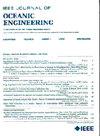A New Active Sonar Detector Based on Beamformed Deep Neural Network
IF 5.3
2区 工程技术
Q1 ENGINEERING, CIVIL
引用次数: 0
Abstract
This article proposes a new active sonar detector based on a beamformed deep neural network (BDNN) in three steps. The process involves a preprocessing step, a deep neural network (DNN) application step, and a subsequent postprocessing step. In the preprocessing step, partial spectra are extracted from multiple directions through frequency-domain beamforming. These partial spectra from different directions serve as DNN input, yielding estimated target probabilities as output in the DNN application step. In the postprocessing step, a multiframe probability multiplication technique is proposed, and the number of frames is determined adaptively. The proposed BDNN generates a gridded azimuth-distance graph, where each grid cell represents the probability of a target's presence at a specific azimuth and distance. To guarantee real-time application, we also propose a graphics processing unit based parallel acceleration method, which increases the computation speed of the beamforming process by nearly two orders of magnitude compared to the CPU. The proposed BDNN is verified through sea and lake trials. The results demonstrate that the proposed BDNN achieves better detection performance compared to the conventional matched filter method and exhibits remarkable generalization capabilities.一种基于波束形成深度神经网络的新型主动声呐探测器
本文分三步提出了一种基于波束形成深度神经网络(BDNN)的新型主动声呐探测器。该过程包括预处理步骤,深度神经网络(DNN)应用步骤和随后的后处理步骤。在预处理步骤中,通过频域波束形成从多个方向提取部分频谱。这些来自不同方向的部分谱作为深度神经网络的输入,在深度神经网络应用步骤中产生估计的目标概率作为输出。在后处理阶段,提出了一种多帧概率乘法技术,并自适应确定帧数。提出的BDNN生成一个网格化的方位角-距离图,其中每个网格单元表示目标在特定方位角和距离上出现的概率。为了保证实时应用,我们还提出了一种基于图形处理单元的并行加速方法,与CPU相比,该方法将波束形成过程的计算速度提高了近两个数量级。提出的BDNN通过海试和湖试进行了验证。结果表明,与传统的匹配滤波方法相比,所提出的BDNN具有更好的检测性能和显著的泛化能力。
本文章由计算机程序翻译,如有差异,请以英文原文为准。
求助全文
约1分钟内获得全文
求助全文
来源期刊

IEEE Journal of Oceanic Engineering
工程技术-工程:大洋
CiteScore
9.60
自引率
12.20%
发文量
86
审稿时长
12 months
期刊介绍:
The IEEE Journal of Oceanic Engineering (ISSN 0364-9059) is the online-only quarterly publication of the IEEE Oceanic Engineering Society (IEEE OES). The scope of the Journal is the field of interest of the IEEE OES, which encompasses all aspects of science, engineering, and technology that address research, development, and operations pertaining to all bodies of water. This includes the creation of new capabilities and technologies from concept design through prototypes, testing, and operational systems to sense, explore, understand, develop, use, and responsibly manage natural resources.
 求助内容:
求助内容: 应助结果提醒方式:
应助结果提醒方式:


